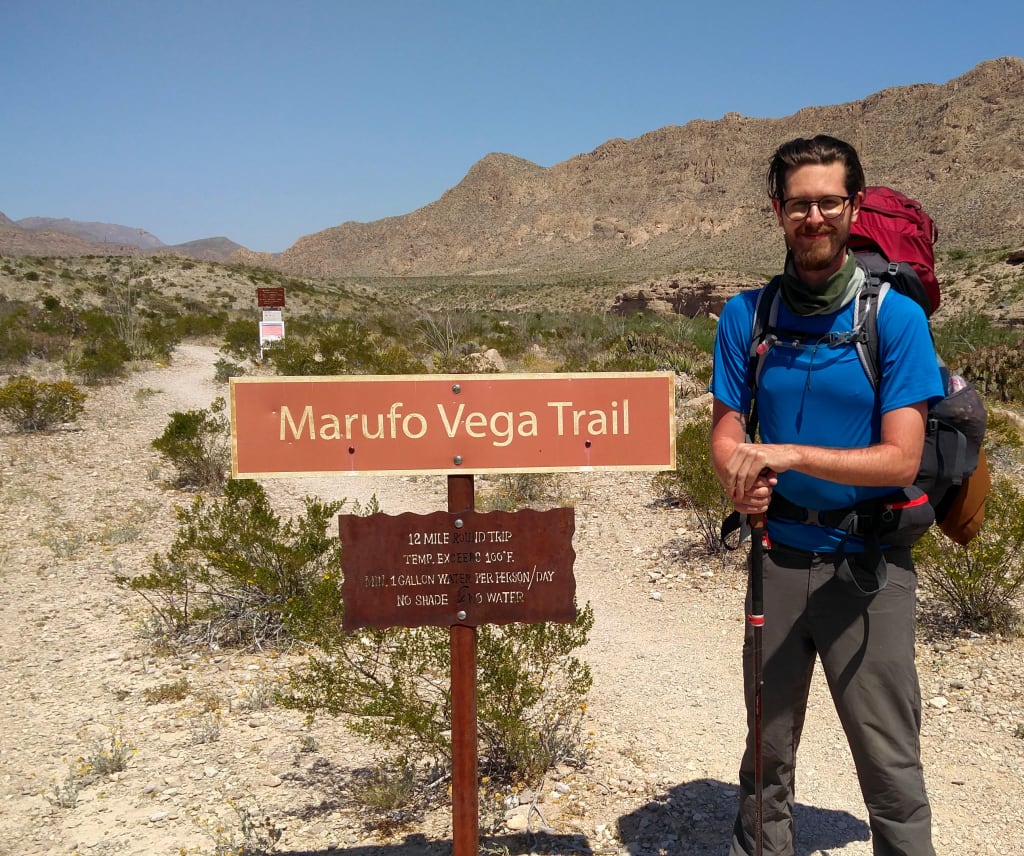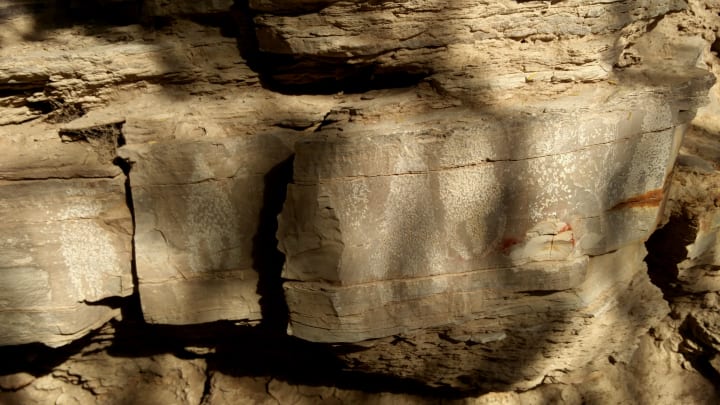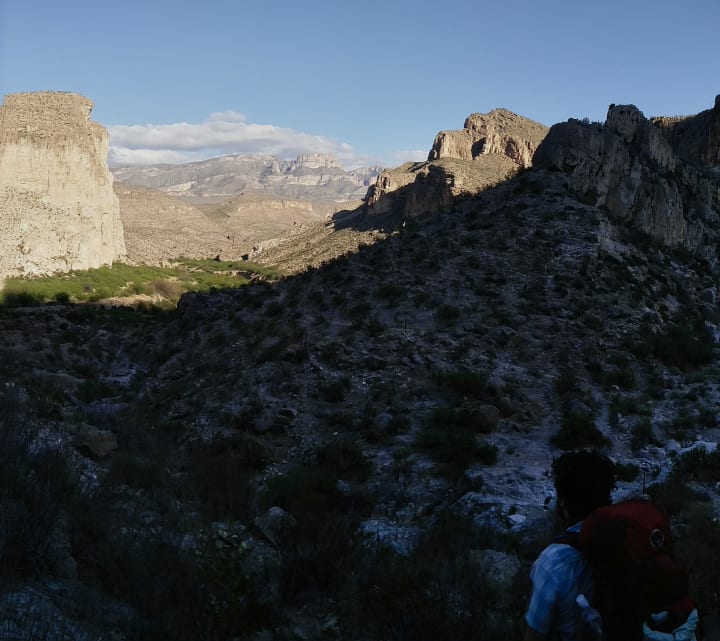Overnight Hiking the Marufo Vega Trail
Day Four of Camping and Hiking in Big Bend National Park

My alarm went off a little before 6a. A coyote yipped and howled in a pattern that almost matched that of my alarm. Ian and I lay in the tent for another hour after the coyote stopped, worried that the sound of the alarm may have drawn its interest. The day before us was going to be a busy one. Ian dressed and headed up to the car to begin getting breakfast ready. I stayed down at the bottom of the hill and broke down our campsite, packing everything into the appropriate carry sacks and brought it all to the car. We packed our big backpacks while we ate.
We carried two meals each: tortillas, peanut butter and honey for lunches, and almost 10 pounds of water each; as well as what we needed to set up camp: tent, sleeping bags, pillows and warmer layers. We left camp in the car by 9a and headed north of the 4x4 road, around Mariscal Mountain and then south. We stuck to 4x4 roads, riding not far from the river until we hit the entrance to the hot spring. The hot spring used to be a tourist attraction a few decades ago, but the buildings stopped being used and fell into disrepair. We poked around some of the old buildings before making our way down the trail.
Along one side of the trail was the river, to our right. Here it was wide and flowed swiftly enough to give would-be swimmers pause.

Along our left were cliffs, blocky and overhanging. Short trees lined the trail between the well-worn path and the cliffs. A small metal sign caught my eye and, upon investigation, it described art, thousands of years old, carved or painted on the rocks. Stepping up to the cliffs, coming into the space between the rock and the trees, the was a buzzing sound. It took me a moment to place, but as I looked around I began to realize that the trees were all in bloom. Tiny white and yellow flowers scattered through their branches. And all of those trees, some 3 or 4 dozen of them, were swarming with bees. The sound was almost imperceptible from the trail, but up against the cliffs, the echo of the buzzing seemed to encompass everything.

The hot spring was small, and crowded. We hung out for a few minutes, but decided to move on. Back in the car, we drove to Rio Grande Village, which was little more than a small store and an area for RV parking. Here we were able to get on WiFi, send out updates to everyone and have a snack. We filled up on water, then took the short drive down to the Marufo Vega trailhead.
It was about 1:30 when we started on the trail. Lathered up in sunscreen, loaded up with 9 liters of water (19.8lbs) and everything we needed to camp for a night we began the long, flat trek along the first mile and half. As the trail snaked along dry watersheds and between boulders we stopped several times to adjust our packs. We climbed out of the lowest point, no relief from the sun anywhere in sight. The trail continued, mostly flat, until there was a sudden, steep change in elevation. We climbed a few hundred feet and found ourselves looking back over the valley we just walked through. In the distance, we could make out the glimmer of the cars parked next to the trailhead.

It was here we stopped and had lunch. Hot tortillas with peanut butter and honey. We drank water, reapplied sunscreen to our arms and continued onward. The trail flattened out again, taking us between small peaks and outcroppings. The landscape on the west side of the hills looks strangely flat. It becomes hard to judge distances. I can spot the trail far ahead of us, cutting to the right to follow along the crest of a hill, and it seems so far ahead. Then, before I realize it, we’ve passed the crest and are descending the other side. I keep turning around and realizing we’ve just, in seemingly no time at all, gone around a mesa that seemed impossibly far away just half an hour ago.
On the other side of that, though, is that there is a sense of traveling very, very far in very little time. And when we check the map, we find we’ve barely gone two miles in an hour.
We arrived at the fork between the north and south segments of the loop. Not remembering that the ranger suggested we begin with the south loop, I suggested we take the north. It would allow us to clear more miles today, and give us an easier walk the following day. So north we went.
We climbed at a steady pace and, soon enough, found ourselves approaching a valley. The trail became steeper and steeper, until we were just walking down large steps formed from boulders and millennia of water running down from the mesas to the river. As we carefully made our way lower, the sun was blocked by the hills behind us. The wind picked up and soon enough I was having to hold a hand against the rocks next for stability.

At the floor of the valley we were no more than a hundred feet from the Rio Grande. It’s not terribly wide at this point, but is flowing quickly. It was getting darker, and starting to get chilly, especially with the wind. We stopped for a moment to get our headlamps out and I put my jacket on. We followed along the trail, finding a place where it had been washed out and we had to climb a vertical wall in order to continue.
The trail wound along a ridge, below us, short trees grew in the sand by the river. As we walked, it became obvious that the only place with a chance of being flat enough the tent was down by the river. So we found a place where we could pick our way down to the sand. We sat and had dinner, the light quickly fading as we ate. We packed up our trash and moved closer to the river, trying to find a spot flat enough to set up.
We found it not more than 20 feet from the water. It wasn’t very flat, and the wind kicked sand up in all directions. We struggled against the wind to get the tent up, rainfly on. While I was inside the tent, inflating our sleeping pads and unrolling our bags, Ian called out, “WHOA, WHOA!”
I looked up and a pack of about 5 wild horses where stopping their gallop 15 feet away from us. They neighed and stomped around for a moment before turning and galloping back the way they came.

We settled into bed, the wind still whipping sand under the fly and through the mesh of the tent. I tucked myself entirely inside my bag, trying to shelter my face from the steady dusting of sand. Despite my exhaustion, sleep didn’t come easy. It was warm, the wind pushed and pulled at the walls o the tent, and I was worried about animals coming down to the river. There was another concern pulling at the back of my mind. This was the first time I had camped with no possible way out. There was no moving to a better spot—it was too dark and too windy for that. There was no car to retreat to. This was it. We were camped there for the night. And the next day we had about 6 miles to walk back to the car.
At some point in the night, the horses returned. Galloping and stomping by the tent, splashing in the water. It didn’t last long before they moved on.






Comments (1)
A very interesting experience, worth a try!